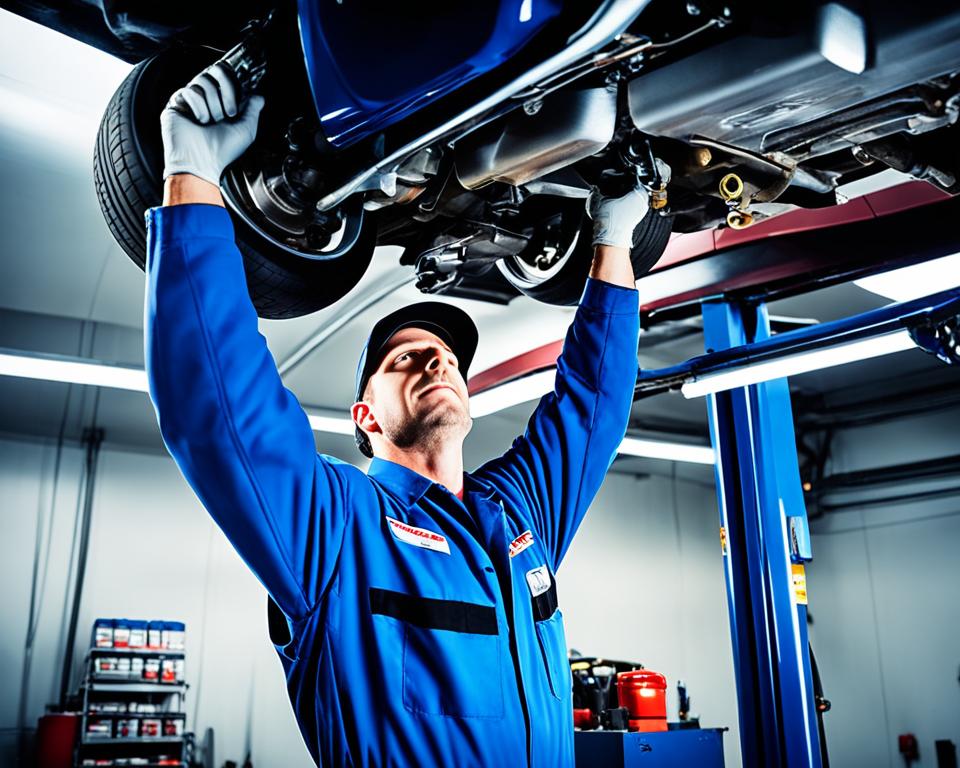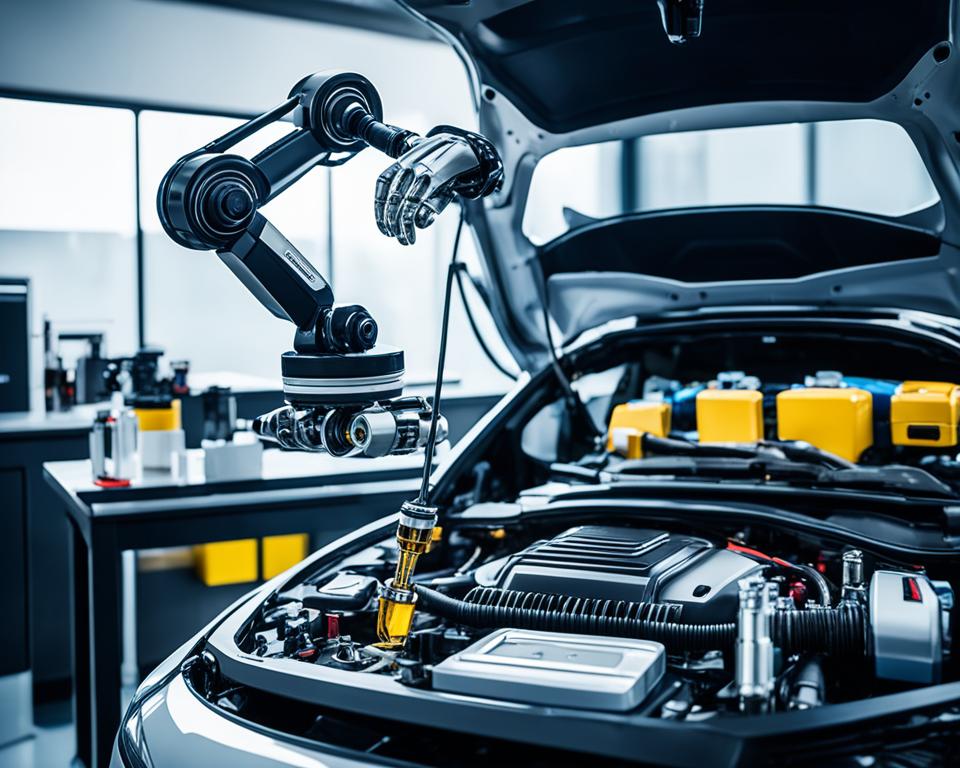Sport & Car
Elevate Your Auto Care: Sophisticated Maintenance Tips for the Modern Car!
When it comes to car maintenance, taking simple steps can go a long way in ensuring the longevity and optimal performance of your vehicle. Whether you’re a car enthusiast or a first-time owner, adopting the right maintenance practices is essential. In this article, I’ll share some advanced car maintenance tips and suggestions that will help you keep your vehicle in top shape. From routine maintenance to DIY care, I’ve got you covered with the best practices for maintaining your car.
Key Takeaways:
- Regular car maintenance is crucial for prolonging the life of your vehicle and ensuring optimal performance.
- Adopting daily driving habits such as smooth acceleration and using neutral gear at red lights can reduce engine wear and improve fuel efficiency.
- Selecting quality fuel and understanding the effects of sediment in gas are important for car performance and longevity.
- Maximizing car durability requires proper maintenance and care, especially in adverse conditions.
- Preserving your car’s value involves reducing weight on your keychain and keeping an auto log for mileage and maintenance tracking.
Understanding Your Vehicle’s Break-In Period
In the early stages of owning a new car, it’s crucial to understand and follow the break-in period guidelines. This period, also known as the vehicle break-in or new car break-in, is the initial phase where the engine and other components of the car need time to settle and optimize performance for the long run.
During the break-in period, certain precautions should be taken to ensure the engine’s longevity and optimal performance. By following these tips, you can minimize potential issues that may arise in the future:
- Adhere to Speed Limits: During the break-in period, it’s important to avoid excessive speed and high RPMs (revolutions per minute). Start by gradually increasing your speed over time to allow the engine to adjust smoothly.
- Avoid Heavy Loads: To avoid straining the engine, try to avoid carrying heavy loads or towing during the break-in period. This will allow the engine to adjust and function optimally without additional stress.
- Limit Excessive Idling: Extended periods of idling can prevent proper engine lubrication and increase wear. When possible, try to keep idling to a minimum during the break-in period.
Following these guidelines will help ensure that your new car’s engine is properly broken in, optimizing its performance and prolonging its lifespan. Taking the necessary precautions during the break-in period can save you from potential maintenance issues down the road.
So, make sure to consult your vehicle’s manual for specific break-in period recommendations and enjoy the benefits of a well-maintained car.
Adopting Daily Driving Habits for Longevity
In order to ensure the longevity of your vehicle and reduce wear and tear, it’s essential to adopt daily driving habits that prioritize smooth acceleration, neutral gear utilization, and efficient engine operation. By making small adjustments to your driving habits, you can significantly improve both the performance and lifespan of your car.
Avoiding Rough Starts and Aggressive Acceleration
One of the easiest ways to minimize engine wear is by avoiding rough starts and aggressive acceleration. Instead of abruptly pressing the gas pedal when starting from a standstill, try to apply gradual pressure to achieve a smoother takeoff. Similarly, when accelerating, opt for a gentle and consistent approach rather than flooring the accelerator pedal. This not only reduces strain on the engine but also contributes to better fuel efficiency.
The Importance of Neutral Gear at Red Lights
When coming to a stop at a red light or in traffic, consider shifting your vehicle into neutral gear. This allows the engine to idle more efficiently without placing unnecessary strain on the transmission and other components. By engaging neutral gear in these situations, you can reduce engine wear and improve fuel economy, especially during extended periods of idling.
Combining Errands to Reduce Engine Wear
In addition to adopting smooth acceleration and neutral gear usage, combining errands whenever possible is an effective way to reduce engine wear and enhance fuel efficiency. By planning your trips and bundling multiple tasks into one outing, you can minimize the number of times you start and stop the engine. This reduces overall wear on the engine and optimizes fuel consumption, leading to significant cost savings over time.
By incorporating these simple daily driving habits into your routine, you can extend the life of your vehicle, maximize fuel efficiency, and minimize the need for costly repairs. Remember, small adjustments to your driving behavior can make a big difference in the long run.

| Driving Habit | Benefit |
|---|---|
| Avoiding rough starts and aggressive acceleration | Reduces engine wear and improves fuel efficiency |
| Using neutral gear at red lights | Minimizes strain on the engine and enhances fuel economy |
| Combining errands | Reduces engine wear and optimizes fuel consumption |
Secrets to Selecting Quality Fuel
In order to ensure optimal car performance and fuel efficiency, it is crucial to select quality fuel for your vehicle. Choosing the right gas station and understanding the effects of sediment in your gas can greatly impact your car’s performance and longevity.
Why Choosing the Right Gas Station Matters
When it comes to fueling up your car, not all gas stations are created equal. Selecting a reputable and reliable gas station is essential to maintain the quality of fuel that goes into your vehicle. A gas station that consistently delivers quality fuel ensures that your car is receiving the right blend of gasoline to optimize its performance. Additionally, choosing a well-maintained gas station with regularly inspected pump filters can help prevent any contaminants from entering your fuel tank.
Understanding the Effects of Sediment in Your Gas
Sediment in gas can have detrimental effects on your car’s engine performance and longevity. Over time, impurities and debris can accumulate in fuel tanks and gas lines, leading to clogged fuel injectors and reduced fuel flow. This can result in decreased fuel efficiency and compromised car performance. By selecting quality fuel and avoiding gas stations with sediment issues, you can minimize the risk of engine damage and ensure your car runs smoothly.
Maximizing Durability When Confronted with Adversity
In order to maximize car durability when faced with adverse conditions such as extreme weather and challenging road conditions, it is crucial to prioritize regular maintenance and implement proper car care strategies. By following these car maintenance tips, you can ensure that your vehicle remains reliable and performs optimally even in the most challenging situations.
One of the key aspects of maintaining car durability is regular servicing and inspection. Routine maintenance checks, including oil changes, filter replacements, and brake inspections, will help identify any potential issues before they become major problems. Additionally, keeping up with scheduled maintenance tasks such as fluid flushes and belt replacements will ensure that your car’s vital systems are in good working condition.
Another important factor in car durability is proper tire care. Inspecting your tires regularly for signs of wear and maintaining the correct tire pressure are essential for safe and efficient driving. In adverse conditions, such as heavy rain or snow, consider equipping your vehicle with specialized tires that are designed to provide better traction and handling.
Furthermore, adopting defensive driving techniques and adjusting your driving style to suit the current road conditions can greatly enhance your car’s durability. By slowing down in adverse weather conditions, maintaining a safe following distance, and avoiding sudden maneuvers or aggressive acceleration, you can reduce the strain on your car’s components and minimize the risk of potential damage.
Moreover, it is crucial to keep your car clean and well-protected from the elements. Regularly washing and waxing your vehicle can help protect the paintwork from the harsh effects of extreme weather, road salts, and debris. Additionally, applying a protective coating to the exterior surfaces can help repel dirt and maintain the car’s appearance.
Remember, by prioritizing regular maintenance, proper tire care, defensive driving, and car protection, you can maximize the durability of your vehicle, ensuring it remains reliable and performs optimally in adverse conditions.

Car Maintenance Tips: Preserving Your Investment
In order to preserve the value of your vehicle as an investment, it is important to follow certain car maintenance tips. By implementing these strategies, you can not only prolong the life of your car but also maintain its value for future resale. In this section, I will provide you with two essential tips for preserving the investment you have made in your vehicle: reducing weight on your keychain and keeping an auto log for mileage and maintenance tracking.
Reducing Weight on Your Keychain
One often overlooked aspect of car maintenance is the weight on your keychain. Carrying a heavy keychain can put unnecessary strain on your ignition switch, potentially leading to failure. To minimize this risk, it is important to reduce the weight on your keychain and only keep essential keys and key fobs. Consider removing unnecessary items such as loyalty cards, trinkets, or other objects that add unnecessary weight. By doing so, you can prevent ignition switch failure and preserve the smooth functioning of your car.
How to Keep an Auto Log for Mileage and Maintenance
Keeping an accurate auto log is another valuable car maintenance tip for preserving your investment. An auto log allows you to track important information such as mileage and maintenance records. By diligently recording this information, you can establish a comprehensive history of your vehicle’s care, which can be valuable when it comes to selling or trading in your car. It also helps you stay on top of regular maintenance tasks, ensuring your car remains in good condition. Consider using a notebook, spreadsheet, or dedicated app to maintain your auto log and update it regularly.
| Information to Record in Your Auto Log: | Frequency |
|---|---|
| Mileage | Each time you fill up your gas tank or at regular intervals (e.g., monthly) |
| Maintenance Tasks | Whenever you perform any maintenance or have it done by a professional |
| Oil Changes | According to your car manufacturer’s recommended schedule (typically every 5,000-7,500 miles) |
| Tire Rotations | Every 5,000-7,500 miles, or as recommended in your car’s manual |
| Other Maintenance | Follow your car manufacturer’s recommended schedule for items such as filter replacements, fluid checks, and brake inspections |
By keeping a detailed auto log, you can easily track your car’s maintenance history and identify any patterns or issues that require attention. This proactive approach to car maintenance will help you preserve the value of your investment and ensure your vehicle performs optimally for many years to come.
Strategies for Insuring and Protecting Your Vehicle
When it comes to your vehicle, ensuring proper insurance coverage and implementing effective protection strategies are essential. Vehicle insurance provides financial protection in the event of accidents, theft, or damage, while preventive measures help safeguard your car from potential risks. By following these strategies, you can have peace of mind knowing that your vehicle is well-protected.
Choosing the right insurance coverage: Selecting the appropriate vehicle insurance is crucial for your car’s protection. Evaluate different insurance providers and policies to find coverage that meets your needs. Consider comprehensive coverage, which extends beyond basic liability insurance and includes coverage for car maintenance, repairs, and replacement.
Implementing theft prevention strategies: Car theft is a prevalent concern, but you can take steps to minimize the risk. Invest in anti-theft devices such as steering wheel locks, alarm systems, and tracking devices. Park your vehicle in well-lit areas and use secure parking facilities whenever possible.
Maintaining comprehensive coverage: Comprehensive coverage not only protects your vehicle in case of accidents but also covers car maintenance. Regular maintenance plays a crucial role in prolonging your car’s lifespan and ensuring optimal performance. By having comprehensive coverage, you can address necessary repairs and maintenance without worrying about the financial burden.
Regular car maintenance: Speaking of car maintenance, routine upkeep and servicing are vital for your vehicle’s longevity and performance. Follow the manufacturer’s recommended maintenance schedule and prioritize tasks such as oil changes, tire rotations, and brake inspections. Proper car maintenance can prevent breakdowns, extend the life of your vehicle, and contribute to safer driving conditions.
By adopting these strategies, you can ensure that your vehicle is protected and maintained properly. Remember, a well-insured and well-maintained car not only provides you with peace of mind but also safeguards your investment for the long term.

Maintaining Aesthetics: Interior and Exterior Care
In order to keep your vehicle looking its best, it is essential to prioritize both interior and exterior care. By following proper cleaning techniques, you can leave a lasting impression with a well-maintained car.
Cleaning Techniques for Lasting Impressions
When it comes to cleaning the interior of your car, there are a few key areas to focus on. Start by vacuuming the upholstery and carpets to remove any dirt, dust, or debris. For stubborn stains, consider using a specialized cleaner that is safe for your specific upholstery material. Don’t forget to clean the windows and windshield using a streak-free glass cleaner for a clear view of the road.
For the exterior of your car, regular washing and waxing can help maintain its shine. Start by rinsing the car with water to remove any loose dirt or debris. Use a soft sponge or microfiber cloth and a gentle car wash soap to clean the surface. Be sure to pay attention to hard-to-reach areas such as wheel wells and door jambs. Once the car is clean, apply a coat of wax to protect the paint and give it a glossy finish.
To clean the dashboard and other interior surfaces, use a mild cleaner and a microfiber cloth. Avoid using harsh chemicals or abrasive materials that could cause damage. Additionally, use a brush or a cloth to clean the air vents, buttons, and knobs, removing any dust or grime that may have accumulated.

Advice on Caring for Your Car’s Weather Stripping and Seals
Weather stripping and seals play a crucial role in preventing water leaks, reducing noise, and improving overall insulation in your car. To keep them in optimal condition, it is important to regularly inspect and maintain them.
Inspect the weather stripping and seals for any signs of wear or damage. Replace any worn-out or cracked weather stripping to ensure a tight seal and prevent leaks. Additionally, apply silicone-based lubricant to keep the weather stripping flexible and prevent it from drying out or becoming brittle.
During the winter months, it is essential to remove any ice or snow buildup from the weather stripping before opening the doors or windows. This will prevent the weather stripping from tearing or getting damaged.
By following these care tips for your car’s interior, exterior, and weather stripping, you can preserve its aesthetics and ensure it remains in top condition for years to come.
Advanced Auto Maintenance: Handling Fluids and Tires
In this section, I will delve into advanced auto maintenance tasks, specifically handling fluids and tires. Effective fluid maintenance and proper tire care are crucial for the optimal performance and longevity of your vehicle. By following these tips, you can ensure that your car runs smoothly and safely for years to come.
Fluid Maintenance:
Regularly checking and maintaining fluid levels in your vehicle is essential to keep it running smoothly. Here are a few fluid maintenance tips to follow:
- Check and change your oil regularly according to the manufacturer’s recommendations. Clean oil helps lubricate the engine and protect it from wear and tear.
- Monitor and top up the coolant level in your radiator to prevent overheating. Coolant also helps protect your engine from freezing during colder temperatures.
- Regularly inspect and refill the brake fluid to ensure proper braking performance. Brake fluid should be clear and free from contaminants for optimal function.
Tire Care:
The condition of your tires plays a significant role in your vehicle’s performance and safety. Follow these tire care tips:
- Regularly check the tire pressure using a reliable pressure gauge. Underinflated or overinflated tires can lead to poor handling, reduced fuel efficiency, and increased risk of blowouts.
- Inspect the tire tread depth to ensure adequate traction. Worn-out tires can compromise your vehicle’s grip on the road, especially in wet or slippery conditions.
- Rotate your tires regularly to promote even wear and extend their lifespan. Consult your vehicle’s manual for recommended rotation intervals.
By incorporating these advanced car maintenance practices into your routine, you can ensure the longevity and performance of your vehicle’s vital fluids and tires.
Conclusion
Throughout this article, I have discussed the importance of regular car maintenance and provided a range of tips and advice to help you elevate your auto care. By following these best practices, you can ensure optimal performance and longevity for your vehicle, while also preserving its value as an investment.
Proper maintenance begins with understanding your vehicle’s break-in period for new cars. By adhering to the recommended guidelines during this crucial phase, you can safeguard the engine and maximize its performance in the long run.
In your daily driving habits, adopting smooth acceleration techniques, utilizing neutral gear at red lights, and combining errands can greatly reduce engine wear and improve fuel efficiency. Additionally, selecting quality fuel and understanding the effects of sediment in your gas are essential for maintaining car performance.
When confronted with adverse conditions, such as extreme weather or challenging road conditions, regular maintenance and proper tire care can ensure your vehicle remains durable and reliable. Additionally, caring for your vehicle’s aesthetics, interior, and exterior, along with regular fluid and tire inspections, are key aspects of advanced auto maintenance that contribute to the overall longevity of your car.
As we conclude, remember that ongoing car maintenance is essential for optimal performance, longevity, and value. Keep this in mind as you embark on your auto care routine, and refer back to the tips provided throughout this article to help guide you along the way.
FAQ
What are some car maintenance tips for keeping my vehicle in optimal condition?
How important is the break-in period for a new car, and what should I do during this time?
What daily driving habits should I adopt to promote longevity and reduce wear and tear on my vehicle?
How can I choose the right fuel for optimal car performance and fuel efficiency?
What should I do to maximize my car’s durability in adverse conditions?
What practices can I adopt to preserve the value of my vehicle as an investment?
How can I insure and protect my vehicle?
What steps can I take to maintain the aesthetics of my vehicle?
What advanced auto maintenance tasks should I be aware of?
Source Links
- https://www.artofmanliness.com/skills/manly-know-how/heading-out-on-your-own-day-21-maintaining-your-car/
- https://www.rd.com/list/car-maintenance-tips-extend-life-car/
- https://www.caranddriver.com/shopping-advice/a35782575/car-ownership-maintenance-repairs-detailing-car-care/

